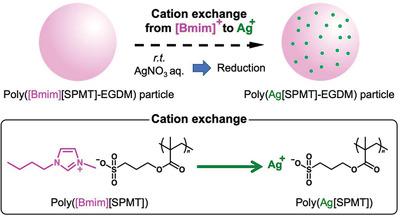当前位置:
X-MOL 学术
›
Macromol. Rapid Commun.
›
论文详情
Our official English website, www.x-mol.net, welcomes your feedback! (Note: you will need to create a separate account there.)
Preparation of Poly(Ionic Liquid) Particles with Anionic Side Chain by Dispersion Polymerization.
Macromolecular Rapid Communications ( IF 4.6 ) Pub Date : 2020-06-16 , DOI: 10.1002/marc.202000271 Takanori Nakano 1 , Mitsuyoshi Yamane 1 , Aya Kurozuka 1 , Toyoko Suzuki 1 , Hideto Minami 1
Macromolecular Rapid Communications ( IF 4.6 ) Pub Date : 2020-06-16 , DOI: 10.1002/marc.202000271 Takanori Nakano 1 , Mitsuyoshi Yamane 1 , Aya Kurozuka 1 , Toyoko Suzuki 1 , Hideto Minami 1
Affiliation

|
Micrometer‐sized poly(ionic liquid) (PIL) particles with an anionic side chain, poly(1‐butyl‐3‐methylimidazolium 3‐sulfopropyl methacrylate) (poly([Bmim][SPMT])), are successfully prepared by dispersion polymerization at 60 °C in ethanol/ethyl acetate (2/8, w/w) with poly(vinylpyrrolidone) as a stabilizer. However, the obtained particles do not maintain the particulate state during drying at room temperature due to poly([Bmim][SPMT])’s low glass‐transition temperature, below room temperature. In order to prevent coalescence and maintain particle shape, a cross‐linking monomer is added after the nucleation stage of dispersion polymerization. Moreover, Fourier‐transform infrared spectroscopy (FT‐IR) demonstrates cation exchange between the obtained particles and metal cations (Ag+).
中文翻译:

分散聚合制备阴离子侧链聚离子液体颗粒。
通过分散聚合成功地制备了具有阴离子侧链的微米级聚(离子液体)(PIL)颗粒,聚(1-丁基-3-甲基咪唑鎓3-甲基磺丙基甲基丙烯酸)(poly([Bmim] [SPMT]))在60°C的乙醇/乙酸乙酯(2/8,w / w)中,以聚乙烯吡咯烷酮为稳定剂。但是,由于聚([Bmim] [SPMT])的室温以下较低的玻璃化转变温度,因此在室温下干燥过程中获得的颗粒无法保持颗粒状态。为了防止聚结并保持颗粒形状,在分散聚合的成核阶段之后添加交联单体。此外,傅立叶变换红外光谱(FT-IR)证明了所得颗粒与金属阳离子(Ag +)之间的阳离子交换。
更新日期:2020-07-20
中文翻译:

分散聚合制备阴离子侧链聚离子液体颗粒。
通过分散聚合成功地制备了具有阴离子侧链的微米级聚(离子液体)(PIL)颗粒,聚(1-丁基-3-甲基咪唑鎓3-甲基磺丙基甲基丙烯酸)(poly([Bmim] [SPMT]))在60°C的乙醇/乙酸乙酯(2/8,w / w)中,以聚乙烯吡咯烷酮为稳定剂。但是,由于聚([Bmim] [SPMT])的室温以下较低的玻璃化转变温度,因此在室温下干燥过程中获得的颗粒无法保持颗粒状态。为了防止聚结并保持颗粒形状,在分散聚合的成核阶段之后添加交联单体。此外,傅立叶变换红外光谱(FT-IR)证明了所得颗粒与金属阳离子(Ag +)之间的阳离子交换。


























 京公网安备 11010802027423号
京公网安备 11010802027423号